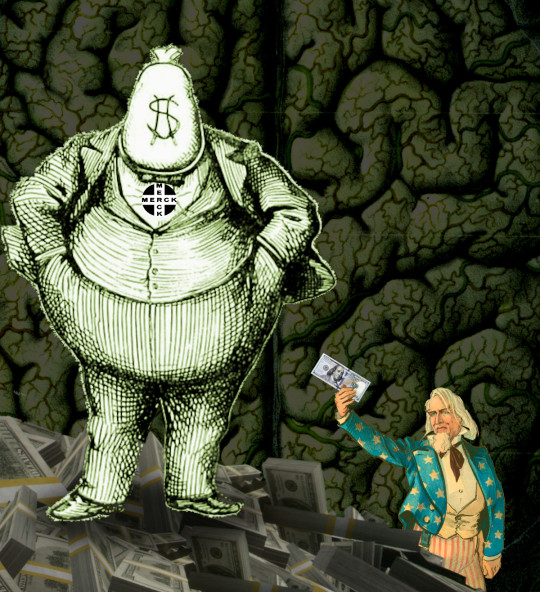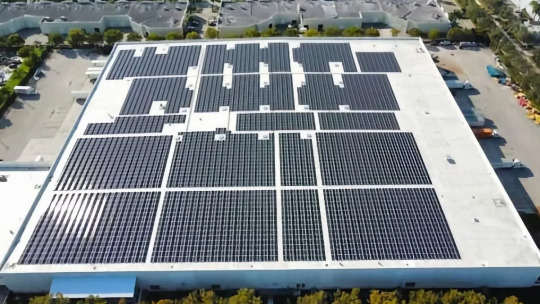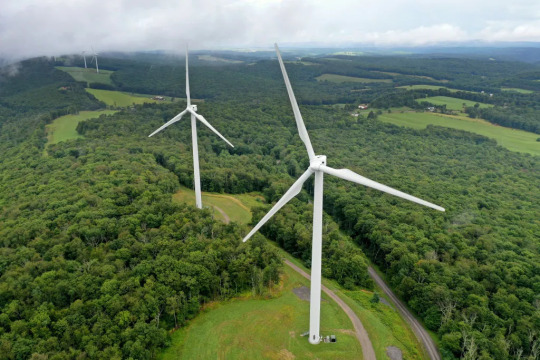#Inflation Reduction Act (IRA)
Explore tagged Tumblr posts
Text
Real innovation vs Silicon Valley nonsense

This is the LAST DAY to get my bestselling solarpunk utopian novel THE LOST CAUSE (2023) as a $2.99, DRM-free ebook!

If there was any area where we needed a lot of "innovation," it's in climate tech. We've already blown through numerous points-of-no-return for a habitable Earth, and the pace is accelerating.
Silicon Valley claims to be the epicenter of American innovation, but what passes for innovation in Silicon Valley is some combination of nonsense, climate-wrecking tech, and climate-wrecking nonsense tech. Forget Jeff Hammerbacher's lament about "the best minds of my generation thinking about how to make people click ads." Today's best-paid, best-trained technologists are enlisted to making boobytrapped IoT gadgets:
https://pluralistic.net/2024/05/24/record-scratch/#autoenshittification
Planet-destroying cryptocurrency scams:
https://pluralistic.net/2024/02/15/your-new-first-name/#that-dagger-tho
NFT frauds:
https://pluralistic.net/2022/02/06/crypto-copyright-%f0%9f%a4%a1%f0%9f%92%a9/
Or planet-destroying AI frauds:
https://pluralistic.net/2024/01/29/pay-no-attention/#to-the-little-man-behind-the-curtain
If that was the best "innovation" the human race had to offer, we'd be fucking doomed.
But – as Ryan Cooper writes for The American Prospect – there's a far more dynamic, consequential, useful and exciting innovation revolution underway, thanks to muscular public spending on climate tech:
https://prospect.org/environment/2024-05-30-green-energy-revolution-real-innovation/
The green energy revolution – funded by the Bipartisan Infrastructure Act, the Inflation Reduction Act, the CHIPS Act and the Science Act – is accomplishing amazing feats, which are barely registering amid the clamor of AI nonsense and other hype. I did an interview a while ago about my climate novel The Lost Cause and the interviewer wanted to know what role AI would play in resolving the climate emergency. I was momentarily speechless, then I said, "Well, I guess maybe all the energy used to train and operate models could make it much worse? What role do you think it could play?" The interviewer had no answer.
Here's brief tour of the revolution:
2023 saw 32GW of new solar energy come online in the USA (up 50% from 2022);
Wind increased from 118GW to 141GW;
Grid-scale batteries doubled in 2023 and will double again in 2024;
EV sales increased from 20,000 to 90,000/month.
https://www.whitehouse.gov/briefing-room/blog/2023/12/19/building-a-thriving-clean-energy-economy-in-2023-and-beyond/
The cost of clean energy is plummeting, and that's triggering other areas of innovation, like using "hot rocks" to replace fossil fuel heat (25% of overall US energy consumption):
https://rondo.com/products
Increasing our access to cheap, clean energy will require a lot of materials, and material production is very carbon intensive. Luckily, the existing supply of cheap, clean energy is fueling "green steel" production experiments:
https://www.wdam.com/2024/03/25/americas-1st-green-steel-plant-coming-perry-county-1b-federal-investment/
Cheap, clean energy also makes it possible to recover valuable minerals from aluminum production tailings, a process that doubles as site-remediation:
https://interestingengineering.com/innovation/toxic-red-mud-co2-free-iron
And while all this electrification is going to require grid upgrades, there's lots we can do with our existing grid, like power-line automation that increases capacity by 40%:
https://www.npr.org/2023/08/13/1187620367/power-grid-enhancing-technologies-climate-change
It's also going to require a lot of storage, which is why it's so exciting that we're figuring out how to turn decommissioned mines into giant batteries. During the day, excess renewable energy is channeled into raising rock-laden platforms to the top of the mine-shafts, and at night, these unspool, releasing energy that's fed into the high-availability power-lines that are already present at every mine-site:
https://www.euronews.com/green/2024/02/06/this-disused-mine-in-finland-is-being-turned-into-a-gravity-battery-to-store-renewable-ene
Why are we paying so much attention to Silicon Valley pump-and-dumps and ignoring all this incredible, potentially planet-saving, real innovation? Cooper cites a plausible explanation from the Apperceptive newsletter:
https://buttondown.email/apperceptive/archive/destructive-investing-and-the-siren-song-of/
Silicon Valley is the land of low-capital, low-labor growth. Software development requires fewer people than infrastructure and hard goods manufacturing, both to get started and to run as an ongoing operation. Silicon Valley is the place where you get rich without creating jobs. It's run by investors who hate the idea of paying people. That's why AI is so exciting for Silicon Valley types: it lets them fantasize about making humans obsolete. A company without employees is a company without labor issues, without messy co-determination fights, without any moral consideration for others. It's the natural progression for an industry that started by misclassifying the workers in its buildings as "contractors," and then graduated to pretending that millions of workers were actually "independent small businesses."
It's also the natural next step for an industry that hates workers so much that it will pretend that their work is being done by robots, and then outsource the labor itself to distant Indian call-centers (no wonder Indian techies joke that "AI" stands for "absent Indians"):
https://pluralistic.net/2024/05/17/fake-it-until-you-dont-make-it/#twenty-one-seconds
Contrast this with climate tech: this is a profoundly physical kind of technology. It is labor intensive. It is skilled. The workers who perform it have power, both because they are so far from their employers' direct oversight and because these fed-funded sectors are more likely to be unionized than Silicon Valley shops. Moreover, climate tech is capital intensive. All of those workers are out there moving stuff around: solar panels, wires, batteries.
Climate tech is infrastructural. As Deb Chachra writes in her must-read 2023 book How Infrastructure Works, infrastructure is a gift we give to our descendants. Infrastructure projects rarely pay for themselves during the lives of the people who decide to build them:
https://pluralistic.net/2023/10/17/care-work/#charismatic-megaprojects
Climate tech also produces gigantic, diffused, uncapturable benefits. The "social cost of carbon" is a measure that seeks to capture how much we all pay as polluters despoil our shared world. It includes the direct health impacts of burning fossil fuels, and the indirect costs of wildfires and extreme weather events. The "social savings" of climate tech are massive:
https://arstechnica.com/science/2024/05/climate-and-health-benefits-of-wind-and-solar-dwarf-all-subsidies/
For every MWh of renewable power produced, we save $100 in social carbon costs. That's $100 worth of people not sickening and dying from pollution, $100 worth of homes and habitats not burning down or disappearing under floodwaters. All told, US renewables have delivered $250,000,000,000 (one quarter of one trillion dollars) in social carbon savings over the past four years:
https://arstechnica.com/science/2024/05/climate-and-health-benefits-of-wind-and-solar-dwarf-all-subsidies/
In other words, climate tech is unselfish tech. It's a gift to the future and to the broad public. It shares its spoils with workers. It requires public action. By contrast, Silicon Valley is greedy tech that is relentlessly focused on the shortest-term returns that can be extracted with the least share going to labor. It also requires massive public investment, but it also totally committed to giving as little back to the public as is possible.
No wonder America's richest and most powerful people are lining up to endorse and fund Trump:
https://prospect.org/blogs-and-newsletters/tap/2024-05-30-democracy-deshmocracy-mega-financiers-flocking-to-trump/
Silicon Valley epitomizes Stafford Beer's motto that "the purpose of a system is what it does." If Silicon Valley produces nothing but planet-wrecking nonsense, grifty scams, and planet-wrecking, nonsensical scams, then these are all features of the tech sector, not bugs.
As Anil Dash writes:
Driving change requires us to make the machine want something else. If the purpose of a system is what it does, and we don’t like what it does, then we have to change the system.
https://www.anildash.com/2024/05/29/systems-the-purpose-of-a-system/
To give climate tech the attention, excitement, and political will it deserves, we need to recalibrate our understanding of the world. We need to have object permanence. We need to remember just how few people were actually using cryptocurrency during the bubble and apply that understanding to AI hype. Only 2% of Britons surveyed in a recent study use AI tools:
https://www.bbc.com/news/articles/c511x4g7x7jo
If we want our tech companies to do good, we have to understand that their ground state is to create planet-wrecking nonsense, grifty scams, and planet-wrecking, nonsensical scams. We need to make these companies small enough to fail, small enough to jail, and small enough to care:
https://pluralistic.net/2024/04/04/teach-me-how-to-shruggie/#kagi
We need to hold companies responsible, and we need to change the microeconomics of the board room, to make it easier for tech workers who want to do good to shout down the scammers, nonsense-peddlers and grifters:
https://pluralistic.net/2023/07/28/microincentives-and-enshittification/
Yesterday, a federal judge ruled that the FTC could hold Amazon executives personally liable for the decision to trick people into signing up for Prime, and for making the unsubscribe-from-Prime process into a Kafka-as-a-service nightmare:
https://arstechnica.com/tech-policy/2024/05/amazon-execs-may-be-personally-liable-for-tricking-users-into-prime-sign-ups/
Imagine how powerful a precedent this could set. The Amazon employees who vociferously objected to their bosses' decision to make Prime as confusing as possible could have raised the objection that doing this could end up personally costing those bosses millions of dollars in fines:
https://pluralistic.net/2023/09/03/big-tech-cant-stop-telling-on-itself/
We need to make climate tech, not Big Tech, the center of our scrutiny and will. The climate emergency is so terrifying as to be nearly unponderable. Science fiction writers are increasingly being called upon to try to frame this incomprehensible risk in human terms. SF writer (and biologist) Peter Watts's conversation with evolutionary biologist Dan Brooks is an eye-opener:
https://thereader.mitpress.mit.edu/the-collapse-is-coming-will-humanity-adapt/
They draw a distinction between "sustainability" meaning "what kind of technological fixes can we come up with that will allow us to continue to do business as usual without paying a penalty for it?" and sustainability meaning, "what changes in behavior will allow us to save ourselves with the technology that is possible?"
Writing about the Watts/Brooks dialog for Naked Capitalism, Yves Smith invokes William Gibson's The Peripheral:
With everything stumbling deeper into a ditch of shit, history itself become a slaughterhouse, science had started popping. Not all at once, no one big heroic thing, but there were cleaner, cheaper energy sources, more effective ways to get carbon out of the air, new drugs that did what antibiotics had done before…. Ways to print food that required much less in the way of actual food to begin with. So everything, however deeply fucked in general, was lit increasingly by the new, by things that made people blink and sit up, but then the rest of it would just go on, deeper into the ditch. A progress accompanied by constant violence, he said, by sufferings unimaginable.
https://www.nakedcapitalism.com/2024/05/preparing-for-collapse-why-the-focus-on-climate-energy-sustainability-is-destructive.html
Gibson doesn't think this is likely, mind, and even if it's attainable, it will come amidst "unimaginable suffering."
But the universe of possible technologies is quite large. As Chachra points out in How Infrastructure Works, we could give every person on Earth a Canadian's energy budget (like an American's, but colder), by capturing a mere 0.4% of the solar radiation that reaches the Earth's surface every day. Doing this will require heroic amounts of material and labor, especially if we're going to do it without destroying the planet through material extraction and manufacturing.
These are the questions that we should be concerning ourselves with: what behavioral changes will allow us to realize cheap, abundant, green energy? What "innovations" will our society need to focus on the things we need, rather than the scams and nonsense that creates Silicon Valley fortunes?
How can we use planning, and solidarity, and codetermination to usher in the kind of tech that makes it possible for us to get through the climate bottleneck with as little death and destruction as possible? How can we use enforcement, discernment, and labor rights to thwart the enshittificatory impulses of Silicon Valley's biggest assholes?

If you'd like an essay-formatted version of this post to read or share, here's a link to it on pluralistic.net, my surveillance-free, ad-free, tracker-free blog:
https://pluralistic.net/2024/05/30/posiwid/#social-cost-of-carbon
#pluralistic#ai#hype#anil dash#stafford beer#amazon#prime#scams#dark patterns#POSIWID#the purpose of a system is what it does#climate#economics#innovation#renewables#social cost of carbon#green energy#solar#wind#ryan cooper#peter watts#the jackpot#ai hype#chips act#ira#inflation reduction act#infrastructure#deb chachra
157 notes
·
View notes
Text
The Inflation Reduction Act: A Green Facade Masking Protectionism and Global Inequality
The Inflation Reduction Act (IRA), signed into law by President Biden on August 16, 2022, has been lauded by its proponents as a monumental step in addressing economic and environmental issues in the United States. But let’s peel back the polished rhetoric, and what do we find? A web of contradictions, protectionism disguised as progress, and a policy framework that, despite its lofty…
#Biden Administration Policies#Carbon Border Adjustment Mechanism (CBAM)#Carbon Emissions Reduction#Climate Change Legislation#Economic Inequality#Environmental Policy Criticism#Global Trade Protectionism#Inflation Reduction Act (IRA)#U.S. Green Technology#U.S. Trade Wars
2 notes
·
View notes
Text
instagram
2 notes
·
View notes
Text

Guy Parsons :: @ParsonsGuy
* * * *
LETTERS FROM AN AMERICAN
[There is a discussion of rape in paragraph 12.]
Three big stories today. First of all, the Democrats are taking a victory lap on the anniversary of the Inflation Reduction Act (IRA), a law that has transformed the U.S. economy and for which not a single Republican voted.
The IRA was the eventual form President Joe Biden’s initial “Build Back Better” plans took. It offered to lower Americans’ energy costs with a 30% tax credit for energy-efficient windows, heat pumps, or newer models of appliances; capped the cost of drugs at $2,000 per year for people on Medicare; and made healthcare premiums fall for certain Americans by expanding the Affordable Care Act.
By raising taxes on the very wealthy and on corporations and bringing the Internal Revenue Service back up to full strength so that it can crack down on tax cheating, as well as saving the government money by permitting it to negotiate drug prices with pharmaceutical companies, the IRA was expected to raise $738 billion. That, plus about $891 billion from other sources, enabled the law to make the largest investment ever in addressing climate change while still bringing down the federal government’s annual deficit.
“This is a BFD,” former President Barack Obama tweeted a year ago.
“Thanks, Obama,” Biden responded.
The law has driven significant investment in U.S. manufacturing. Indeed, the chief executive officer of U.S. Steel recently said the law should be renamed the “Manufacturing Renaissance Act,” as manufacturers return previously offshored production to the U.S. That same shift has brought supply chains back to the U.S. These changes have meant new, well-paid manufacturing jobs that have been concentrated in Republican-dominated states and in historically disadvantaged communities.
Scientists Alicia Zhao and Haewon McJeon, who recently published an article in Science, today wrote that the IRA “brings the US significantly closer to meeting its 2030 climate target [of cutting greenhouse gas emissions to 50–52% below 2005 levels], taking expected emissions from 25–31% below 2005 levels down to 33–40% below.”
While Republican presidential candidates took shots at the IRA today—former South Carolina governor Nikki Haley called it “a communist manifesto”—Democrats have pointed out that Republicans have been eager to take credit for IRA investments in their districts without mentioning either that they voted against the IRA or that they are still trying to repeal it.
If the Democrats are taking a victory lap for passing this transformative law a year ago, the second big story today showed the effort to steal the 2020 presidential election was fully formed earlier than had been established previously. That story came from MSNBC’s Ari Melber, who revealed a video taken by Danish filmmaker Christoffer Guldbrandsen of Trump ally Roger Stone plotting to overturn the results of the 2020 presidential election on November 5, 2020, two days before the election was called for President Biden.
In the video, Stone dictated to an associate a statement saying that “any legislative body may decide on the basis of overwhelming evidence of fraud to send electors to the Electoral College who accurately reflect the president’s legitimate victory in their state, which was illegally denied him through fraud. We must be prepared to lobby our Republican legislatures…by personal contact and by demonstrating the overwhelming will of the people in their state—in each state—that this may need to happen,” he said.
This video, recorded while the election was not yet decided, recalls the statement of Trump ally Steve Bannon, who told a group of associates on October 31, 2020—before the election—that Trump simply planned to declare he had won, claiming that the expected wave in favor of Biden was fraudulent. “What Trump’s gonna do is just declare victory. Right? He’s gonna declare victory. But that doesn’t mean he’s a winner,” Bannon said. “He’s just gonna say he’s a winner.”
The third big story of today shows how Trump Republicans think about women. It hits hard in the wake of this week’s story in Time magazine of the 13-year-old Mississippi girl who just gave birth after being raped by a stranger in her yard. She was unable to obtain an abortion because of Mississippi’s abortion ban. She is scheduled soon to start seventh grade.
Yesterday, far away from the home of that Mississippi girl, a three-judge panel of the U.S. Court of Appeals for the Fifth Circuit handed down a decision about the use of the abortion drug mifepristone in the case of Alliance for Hippocratic Medicine v. Food and Drug Administration (FDA). Last year, as soon as the Supreme Court overturned the 1973 Roe v. Wade decision recognizing the constitutional right to abortion, antiabortion doctors tried to get mifepristone taken off the market by arguing that the FDA should never have approved it when it did so in 2000. The Alliance for Hippocratic Medicine was incorporated just after last June’s Dobbs v. Jackson Women’s Health decision overturned Roe v. Wade.
In April 2023, Trump appointee and longtime abortion opponent Texas judge Matthew Kacsmaryk issued a preliminary ruling invalidating that approval. The federal appeals court yesterday said the drug should be legal, but significantly limited its use by saying it could not be sent through the mail or prescribed without an in-person visit to a doctor, cutting midwives and other healthcare providers out of the process.
Judge James Ho, who was sworn into office by Supreme Court Justice Clarence Thomas in his billionaire benefactor Harlan Crow’s library in 2018 (Texas Republican senator Ted Cruz was also there), wrote his own opinion in the case in order to expand on what he sees as “the historical pedigree of Plaintiffs’ conscience injury, and to explore how Plaintiffs suffer aesthetic injury as well.”
Antiabortion doctors suffer a moral injury when they are forced to help patients who have complications from the use of mifepristone, Ho wrote, because they are forced to participate in an abortion against their principles.
Those doctors also experience an aesthetic injury when patients choose abortion because, as one said, “When my patients have chemical abortions, I lose the opportunity…to care for the woman and child through pregnancy and bring about a successful delivery of new life.” Indeed, Ho wrote, “It’s well established that, if a plaintiff has ‘concrete plans’ to visit an animal’s habitat and view that animal, that plaintiff suffers aesthetic injury when an agency has approved a project that threatens the animal.”
In cases where the government “approved some action—such as developing land or using pesticides—that threatens to destroy…animal or plant life that plaintiffs wish to enjoy,” that injury “is redressable by a court order holding unlawful and setting aside the agency approval. And so too here. The FDA has approved the use of a drug that threatens to destroy the unborn children in whom Plaintiffs [that is, the antiabortion doctors] have an interest.”
“Unborn babies are a source of profound joy for those who view them,” Ho wrote. “Expectant parents eagerly share ultrasound photos with loved ones. Friends and family cheer at the sight of an unborn child. Doctors delight in working with their unborn patients—and experience an aesthetic injury when they are aborted.”
The decision will be on hold until the appeals process is completed.
LETTERS FROM AN AMERICAN
HEATHER COX RICHARDSON
#Letters from an american#heather cox richardson#corrupt SCOTUS#The Biden Administration#IRA#Inflation Reduction Act#jobs#doing your job#women#abortion
2 notes
·
View notes
Text
One would not know it from the Democratic obsession with a “just transition” away from fossil fuels, but America’s contribution to global greenhouse gases is relatively small and has fallen rapidly over the past two decades. In other words, even if the US achieved Biden’s unrealistic decarbonisation goals, most global greenhouse gas emissions would be unaffected.
Politicians are always vulnerable to the tendency to try to promote multiple unrelated goals with a single piece of legislation. Franklin Roosevelt’s National Recovery Act (1933) had good elements, but collapsed because it tried to stimulate the depressed economy and restructure American industry at the same time. With the IRA, Biden and congressional Democrats indulged in a similar temptation. Here, just one piece of legislation was supposed to accelerate the “green transition” away from fossil fuels to Net Zero, onshore manufacturing supply chains that have been lost to China and other countries, create great numbers of well-paying new jobs, revitalise “left-behind” local communities, and promote racial and gender “justice”.
2 notes
·
View notes
Text
No paywall version here.
"Two and a half years ago, when I was asked to help write the most authoritative report on climate change in the United States, I hesitated...
In the end, I said yes, but reluctantly. Frankly, I was sick of admonishing people about how bad things could get. Scientists have raised the alarm over and over again, and still the temperature rises. Extreme events like heat waves, floods and droughts are becoming more severe and frequent, exactly as we predicted they would. We were proved right. It didn’t seem to matter.
Our report, which was released on Tuesday, contains more dire warnings. There are plenty of new reasons for despair. Thanks to recent scientific advances, we can now link climate change to specific extreme weather disasters, and we have a better understanding of how the feedback loops in the climate system can make warming even worse. We can also now more confidently forecast catastrophic outcomes if global emissions continue on their current trajectory.
But to me, the most surprising new finding in the Fifth National Climate Assessment is this: There has been genuine progress, too.
I’m used to mind-boggling numbers, and there are many of them in this report. Human beings have put about 1.6 trillion tons of carbon in the atmosphere since the Industrial Revolution — more than the weight of every living thing on Earth combined. But as we wrote the report, I learned other, even more mind-boggling numbers. In the last decade, the cost of wind energy has declined by 70 percent and solar has declined 90 percent. Renewables now make up 80 percent of new electricity generation capacity. Our country’s greenhouse gas emissions are falling, even as our G.D.P. and population grow.
In the report, we were tasked with projecting future climate change. We showed what the United States would look like if the world warms by 2 degrees Celsius. It wasn’t a pretty picture: more heat waves, more uncomfortably hot nights, more downpours, more droughts. If greenhouse emissions continue to rise, we could reach that point in the next couple of decades. If they fall a little, maybe we can stave it off until the middle of the century. But our findings also offered a glimmer of hope: If emissions fall dramatically, as the report suggested they could, we may never reach 2 degrees Celsius at all.
For the first time in my career, I felt something strange: optimism.
And that simple realization was enough to convince me that releasing yet another climate report was worthwhile.
Something has changed in the United States, and not just the climate. State, local and tribal governments all around the country have begun to take action. Some politicians now actually campaign on climate change, instead of ignoring or lying about it. Congress passed federal climate legislation — something I’d long regarded as impossible — in 2022 as we turned in the first draft.
[Note: She's talking about the Inflation Reduction Act and the Infrastructure Act, which despite the names were the two biggest climate packages passed in US history. And their passage in mid 2022 was a big turning point: that's when, for the first time in decades, a lot of scientists started looking at the numbers - esp the ones that would come from the IRA's funding - and said "Wait, holy shit, we have an actual chance."]
And while the report stresses the urgency of limiting warming to prevent terrible risks, it has a new message, too: We can do this. We now know how to make the dramatic emissions cuts we’d need to limit warming, and it’s very possible to do this in a way that’s sustainable, healthy and fair.
The conversation has moved on, and the role of scientists has changed. We’re not just warning of danger anymore. We’re showing the way to safety.
I was wrong about those previous reports: They did matter, after all. While climate scientists were warning the world of disaster, a small army of scientists, engineers, policymakers and others were getting to work. These first responders have helped move us toward our climate goals. Our warnings did their job.
To limit global warming, we need many more people to get on board... We need to reach those who haven’t yet been moved by our warnings. I’m not talking about the fossil fuel industry here; nor do I particularly care about winning over the small but noisy group of committed climate deniers. But I believe we can reach the many people whose eyes glaze over when they hear yet another dire warning or see another report like the one we just published.
The reason is that now, we have a better story to tell. The evidence is clear: Responding to climate change will not only create a better world for our children and grandchildren, but it will also make the world better for us right now.
Eliminating the sources of greenhouse gas emissions will make our air and water cleaner, our economy stronger and our quality of life better. It could save hundreds of thousands or even millions of lives across the country through air quality benefits alone. Using land more wisely can both limit climate change and protect biodiversity. Climate change most strongly affects communities that get a raw deal in our society: people with low incomes, people of color, children and the elderly. And climate action can be an opportunity to redress legacies of racism, neglect and injustice.
I could still tell you scary stories about a future ravaged by climate change, and they’d be true, at least on the trajectory we’re currently on. But it’s also true that we have a once-in-human-history chance not only to prevent the worst effects but also to make the world better right now. It would be a shame to squander this opportunity. So I don’t just want to talk about the problems anymore. I want to talk about the solutions. Consider this your last warning from me."
-via New York Times. Opinion essay by leading climate scientist Kate Marvel. November 18, 2023.
#WE CAN DO THIS#I SO TRULY BELIEVE THAT WE CAN DO THIS#WE CAN SAVE OURSELVES AND THE WORLD ALONG WITH US#climate crisis#united states#climate change#conservation#hope posting#sustainability#climate news#climate action#climate emergency#fossil fuels#global warming#environmentalism#climate hope#solarpunk#climate optimism#climate policy#earth#science#climate science#meteorology#extreme weather#renewable energy#solar power#wind power#renewables#carbon emissions#climate justice
33K notes
·
View notes
Text
youtube
Ok so this is a fantastic breakdown of some huge legislation that was passed in the US about clean energy last year, and I feel like we should be talking way more about this even now.
News goons talking about this weren't exaggerating when they were boggling over 'the biggest climate change bill basically ever' because yeah, it kind of is. It's incentivizing clean energy infrastructure on basically every level, it's supporting electric conversion, it's supporting conservation, it's penalizing methane leaks, it's--ok yeah it's in the video. There's more that the video doesn't cover, but like, from what I can tell this is a good summary.
Important details about the Inflation Reduction Act that I feel should be especially highlighted: if you electrify your home and your car you might qualify for major tax breaks. The tax breaks vary depending on whether you're looking at electric cars vs non-gas heating and appliances for your home, as well as how much you make compared to your city's median income, so I'm not going to get into it here, but this is specifically looking to help disadvantaged communities.
Please keep learning more about the IRA!!! I'll also be looking and I'll share anything interesting that I find.
#environmentalism#clean energy#pollution#inflation reduction act#hank green#ira#vlog brothers#america#Youtube
0 notes
Text
https://www.rashmee.com/2023/08/17/america-bidenomics-ira-green-investment/

0 notes
Text

"The administration is insisting that London respect an agreement it made with the European Union that draws a customs border in the Irish Sea between mainland Britain and Northern Ireland. That arrangement, called the Northern Ireland Protocol, has enraged the enclave’s pro-British loyalists, who say it pulls Northern Ireland closer to the neighboring Republic of Ireland, cementing Protestant suspicions of what they say is Biden’s bias toward Irish Republicanism, and Belfast Accords be damned"
Or, maybe "IRA" stands for the Biden administration's "Inflation Reduction Act"
0 notes
Text
#climate#climate lyric#lyric#musical#rent#lyric parody#seasons of love#seasons of change#inflation reduction act#IRA#climate policy#climate action
0 notes
Text
Capitalists hate capitalism

As the Marxist agitator Adam Smith once said, “People of the same trade seldom meet together, even for merriment and diversion, but the conversation ends in a conspiracy against the public, or in some contrivance to raise prices.”
Smith understood that capitalists hate capitalism. They don’t want to compete with one another, because that would interfere with their ability to raise the prices their customers pay and reduce the wages they pay their workers. Thus Peter Thiel’s anticapitalist rallying cry, “competition is for losers,” or Warren Buffett’s extreme horniness for businesses with “wide, sustainable moats.”
These anti-capitalist capitalists love big government. They love no-bid military contracts, they love ACA subsidies for health insurance companies, they love Farm Bill cash for Cargill and Monsanto. What they don’t love is markets.
Case in point: pharma giant Merck. The Inflation Reduction Act (IRA) includes a provision that allows Medicare to (finally) start (weakly) negotiating the prices it pays for (a tiny handful of) drugs. If you’re scratching your head and wondering if you understood that correctly, let me assure you, you did: the US government is currently prohibited from negotiating drug prices when it bargains with pharma companies.
In other words: Medicare simply pays a pharma companies — whose products build on billions in publicly funded basic research, whose taxes are reduced by billions in research credits, whose patents are backstopped by billions in enforcement — whatever it demands.
To do otherwise, you see, would be socialism. Markets are “efficient” because they “discover prices” through bidding and selling. In the case of publicly purchased drugs, the price that Uncle Sucker “discovers” is inevitably “a titanic sum” or possibly “add a couple more zeroes, wouldya?”
Enter the IRA. Starting in 2026, Medicare will be permitted to negotiate the price of ten (10) drugs. The negotiations will use the prices of other drugs from the dysfunctional, monopolized market as a starting point and go up from there. The negotiations go on for three years, and there are multiple stages where pharma companies can hit pause with court challenges:
https://prospect.org/health/2023-05-11-regulators-bungling-drug-price-reform/
The system will not consider the prices that Medicaid or the VA (which are allowed to bargain on prices) pay. Nor will it consider the prices that other governments pay — the US is alone in the wealthy world in offering the anticapitalist price-taking posture when dickering with the pharma companies.
But this isn’t enough for Merck. They are suing the Biden administration over the IRA’s drug pricing plan, arguing that it is an unconstitutional taking under the Fifth Amendment:
https://www.cnbc.com/2023/06/06/merck-sues-biden-administration-over-medicare-drug-price-negotiations.html
Merck is represented by Big Law firm Jones Day, who made their bones by representing the RJ Reynolds from smokers with lung-cancer, arguing that the smoking/cancer link wasn’t scientifically sound. That’s not the only fanciful argument they put before a judge: Jones Day also represented Trump in his attempts to overturn the 2020 election (they also hired Trump’s counsel Don McGahn as he exited the White House’s revolving door).
As Ryan Cooper writes for The American Prospect, Merck’s argument is that the “fair market” value of its drugs can only be discovered if its single largest customer — Medicare — simply pays whatever Merck demands of it:
https://prospect.org/health/2023-06-08-merck-negotiating-drug-prices-unconstitutional/
They explicitly denounce the idea that a powerful buyer should use its market power to extract price concessions from sellers like Merck: “leveraging all federal insurance benefits (amounting to over half of the prescription drug market) to coerce companies to abandon their First and Fifth Amendment rights is a quintessential unconstitutional condition.”
Rebutting this argument, Health Secretary Xavier Becerra said, “negotiating for the best price is as American as apple pie. Since when is competition in this American system a bad thing? Why should we be the patsies around the world and pay the highest prices for medicines?”
The irony here is that Merck itself is a very powerful buyer. Whether negotiating commercial leases, raw materials or wages, Merck is ruthless in extracting the lowest prices it can from its suppliers. The company attained its massive scale the old fashioned way: buying it. By drawing on its nearly limitless access to the capital markets, Merck bought out dozens of its competitors:
https://mergr.com/merck-acquisitions
Anticapitalist investors funded these acquisitions in the expectation that Merck would be able to use its market dominance to pay suppliers less, charge customers more, and use some of the resulting windfall to corrupt and bully its regulators so that it could buy still more companies, charge still higher prices, and impose crushingly low prices on still more suppliers.
The IRA’s drug-bargaining provisions are extraordinarily weak. When they were first mooted in 2021, I talked about how Democrats were caving on muscular drug price controls that would benefit every American (except a handful of pharma shareholders):
https://pluralistic.net/2021/11/18/bipartisan-consensus/#corruption
They did so despite wild, bipartisan support for imposing price discipline on Big Pharma, and ending the 300% premium Americans pay for their drugs relative to their cousins abroad. 95% of Democrats support strong price controls; so do 82% of independents — and 71% of Republicans:
https://www.rwjf.org/en/library/research/2021/11/healthcare-affordability--majority-of-adults-support-significant-changes-to-the-health-system.html
No one believes Big Pharma’s scare stories about how this would kill R&D: 93% of Americans reject this idea, including 90% of Republicans. They’re right — nearly all US basic pharma R&D is directly funded by the federal government, with pharma companies privatizing the gains:
https://khn.org/news/article/public-opinion-prescription-drug-prices-democratic-plan/
Despite the fact that really whipping the shit out of Big Pharma would be both popular and good for America, the Dems’ final version of pharma bargaining is a barely-there nothingburger where ten drugs will become slightly cheaper, after the next federal election. This is called “political realism” and it’s a fantasy.
The idea that limiting drug controls to the faintest, most modest measures would make them easier to attain was obvious nonsense from the start, and Merck’s anticapitalist lawsuit proves it. Merck will settle for nothing less than total central planning — by Merck. For Merck, the role of the federal government is to wave through a stream of mergers culminating in Merck’s ownership of every major drug; patent extensions for these drugs to carry them into the 25th century and beyond, and unlimited sums paid for these drugs on Medicare.
Given all that, there would have been no downside to the Dems passing an IRA that subjected the drug companies the same modest, commensense, market-based discipline we see in Canada, or the UK, or France, or Germany, or Switzerland.
But that’s not the IRA we got. Instead of defending a big, visionary program in court, the Biden admin is facing down Jones Day and Merck to defend the most yawn-inducing, incrementalist half-measure. What a wasted opportunity.

If you’d like an essay-formatted version of this post to read or share, here’s a link to it on pluralistic.net, my surveillance-free, ad-free, tracker-free blog:
https://pluralistic.net/2023/06/09/commissar-merck#price-giver

[Image ID: A caricature of a businessman with a money-bag for a head and a stickpin bearing the Merck logo, standing atop a pile of bundled $100 bills. At the bottom of the pile, a frowning, disheveled Uncle Sam offers up a $100 bill.]

Image: Flying Logos (modified) https://commons.wikimedia.org/wiki/File:Over_$1,000,000_dollars_in_USD_$100_bill_stacks.png
CC BY-SA 4.0 https://creativecommons.org/licenses/by-sa/4.0/deed.en
#pluralistic#merck#guillotine watch#big pharma#markets#anticapitalism#capitalism#pharma#whiners#bargaining power#price makers#price takers#uncle sucker#inflation reduction act#ira
223 notes
·
View notes
Text
I think that one of the things I find most frustrating about the tariffs conversation (and I find a lot of it frustrating) is... well, okay, it's two things, which are related:
ONE: MAGA are stealing leftist talking points
TWO: That's not how protectionist tariffs work. (This is probably the more important one.)
So.
ONE: The rhetoric of 'temporary hardship to reach eventual greater collective stability' is something that the left generally says with a little more sincerity, oftentimes with things like taxes for public infrastructure or welfare.
It also generally means that everyone experiences a touch of hardship, but the wealth is reinvested into the economy to boost the collective good; the sincerity is low with centrists, but higher with the far left.
The hardship is also more likely to not be moving money to the wealthy, something that is very much happening here. There are some massive shortfalls in tax income these past few years, some of which have been going on for decades, like the subsidization of the fossil fuel industry or unusually high investment in the military, but a big one recently has been the 2017 tax cuts that Trump introduced for the wealthy in his first term. They are, from articles I've seen, responsible for trillions in lost revenue per year sine their introduction, and while they expire in 2025, Trump and this Republican Congress have made it clear that they intend to extend those tax cuts as long as they can. The tariffs are to cover that gap in the budget, meaning that everyone is paying more in taxes, on goods that are disproportionately consumed by the lower and middle classes, in order to cover the tax breaks that billionaires got.
Very much stealing from the poor to give to the rich! That's what the tariffs are about!
e.g. yes you're paying a few extra dollars in taxes this year, but it's being invested in developing a free and reduced school lunch program; while you won't see any immediate benefits, and you'll be a little strapped for cash for month or two if you're living paycheck to paycheck, but you'll see a huge load off your mind come September. Could also be a few extra dollars for an infrastructure project, which takes ten years to build... but once it's built, your commute is cut in half because of the new bridge, or the electricity is subsidized by some new wind farms, or the landfill has been assessed and built over to be a safe, clean park. This second example about infrastructure is Biden's Inflation Reduction Act, which fed money into infrastructure work and other major projects across the country; in many cases, state Senators, congresspeople, and governors who had voted or campaigned against the IRA would then take credit for the benefits their constituents saw.
TWO: You can't use protectionist tariffs to revive local industry without investing in it. High tariffs can minimize damage to the economy if the industry hasn't already left.
If the factories are still around, and the employees are still there and knowledgeable, and the resources haven't been left to diminish on their own, then you protect them with tariffs in the immediate aftermath of a shift in the status quo. You prevent the 'theft of business' with the tariffs, and since it all just seems to be business as usual domestically, it's a blip in the radar for consumers. A bit more complicated if the domestic market has also been exporting the product, as markets abroad will shift to the cheaper product you are protecting against, but you now have a bit more time to innovate a reason to keep market share.
If the industry has been allowed to diminish, or never really existed in the first place (we can't grow coffee or bananas or avocado or mangos at an industry scale, we do not have the weather for it), then a sudden implementation of protectionist tariffs will pass costs along to the consumer until the industry is up and running again.
You know how you fix that? Subsidize the industry you're trying to revive.
In 1910, there were 144,607 people employed in clothing factories in the US (1910 census, employment). This doesn't include people working in shoe factories (181,010), tanneries (33,553), dressmakers and seamstresses (449,342; presumably separated from the first statistic by not being in a factory), dyers (14,050), sewers and sewing machine operatives (291,209), shoemakers and cobblers not in factories (69,570), and the hundreds of thousands of people in the textiles alone (I'm not doing the math, but it's over a million). So we're looking at several million people in the garment industry in the US, in 1910.
In 2020, the combined category of Textile, Apparel, and Furnishing employment contained a total of 16,510 people.
You cannot bring an industry like that back to the US without heavily, heavily subsidizing it to
A. Keep the costs down to where the public can still buy clothing without making it so the people suddenly in this industry are paid pennies on the hour.
B. Train this new generation of people in an industry that barely exists anymore.
C. Build the infrastructure to support the industry, from cotton gins to sewing factories.
You can't bring back an industry that was in the millions in 1910 when there are less than 20,000 people doing it now, in a population that has more than tripled (92mill in 1910, 331mill in 2020).
I just. You have to feed those tariffs into rebuilding the industry. You can't feed them into tax breaks for the wealthy if your stated goal is to rebuild industry. I know that feeding money to his rich friends is the goal for Trump, but I'm so incredibly frustrated that people don't seem to get the basic functions of protectionist tariff application.
Almost forgot to advertize myself since this was just me venting about current events, inspired by a LegalEagle video, but:
Prompt me on ko-fi! I’m trying to move out of my parents’ house.
#economics#tariffs#united states#politics#history#protectionism (trade)#industry#phoenix talks#phoenix politics
205 notes
·
View notes
Text
The Best News of Last Week - August 21, 2023
🌊 - Discover the Ocean's Hidden Gem Deep down in the Pacific
1. Massachusetts passed a millionaire's tax. Now, the revenue is paying for free public school lunches.

Every kid in Massachusetts will get a free lunch, paid for by proceeds from a new state tax on millionaires.
A new 4% tax on the state's wealthiest residents will account for $1 billion of the state's $56 billion fiscal budget for 2024, according to state documents. A portion of those funds will be used to provide all public-school students with free weekday meals, according to State House News Service.
2. Plant-based filter removes up to 99.9% of microplastics from water

Researchers may have found an effective, green way to remove microplastics from our water using readily available plant materials. Their device was found to capture up to 99.9% of a wide variety of microplastics known to pose a health risk to humans.
3. Scientists Find A Whole New Ecosystem Hiding Beneath Earth's Seafloor
youtube
Most recently, aquanauts on board a vessel from the Schmidt Ocean Institute used an underwater robot to turn over slabs of volcanic crust in the deep, dark Pacific. Underneath the seafloor of this well-studied site, the international team of researchers found veins of subsurface fluids swimming with life that has never been seen before.
It's a whole new world we didn't know existed.
4. How solar has exploded in the US in just a year

Solar and storage companies have announced over $100 billion in private sector investments in the US since the passage of the Inflation Reduction Act (IRA) a year ago, according to a new analysis released today by the Solar Energy Industries Association (SEIA).
Since President Joe Biden signed the IRA in August 2022, 51 solar factories have been announced or expanded in the US.
5. Researchers have identified a new pack of endangered gray wolves in California

A new pack of gray wolves has shown up in California’s Sierra Nevada, several hundred miles away from any other known population of the endangered species, wildlife officials announced Friday.
It’s a discovery to make researchers howl with delight, given that the native species was hunted to extinction in California in the 1920s. Only in the past decade or so have a few gray wolves wandered back into the state from out-of-state packs.
6. Record-Breaking Cleanup: 25,000 Pounds of Trash Removed from Pacific Garbage Patch

Ocean cleanup crews have fished out the most trash ever taken from one of the largest garbage patches in the world.
The Ocean Cleanup, a nonprofit environmental engineering organization, saw its largest extraction earlier this month by removing about 25,000 pounds of trash from the Great Pacific Garbage Patch, Alex Tobin, head of public relations and media for the organization
7. The Inflation Reduction Act Took U.S. Climate Action Global

The U.S. Inflation Reduction Act (IRA) aimed to promote clean energy investments in the U.S. and globally. In its first year, the IRA successfully spurred other nations to develop competitive climate plans.
Clean energy projects in 44 U.S. states driven by the IRA have generated over 170,600 jobs and $278 billion in investments, aligning with Paris Agreement goals.
---
That's it for this week :)
This newsletter will always be free. If you liked this post you can support me with a small kofi donation here:
Buy me a coffee ❤️
Also don’t forget to reblog this post with your friends.
1K notes
·
View notes
Text
Excerpt from this story from High Country News:
The billions of dollars approved by Congress to clean up abandoned oil and gas wells have been frozen as part of President Donald Trump’s sweeping cuts to government spending, creating concerns that the cleanup will be halted just as it’s getting started.
President Trump’s barrage of executive orders included a January directive called “Unleashing American Energy,” which, among other provisions, ordered that federal agencies stop distributing money appropriated by President Joe Biden’s Inflation Reduction Act (IRA) and the Infrastructure Investment and Jobs Act (IIJA).
The Trump administration titled this section of the order “Terminating the Green New Deal.” But in freezing this congressionally approved spending, the administration halted a program that paid for plugging and reclaiming so-called “orphaned” or abandoned oil and gas wells. The order stated that agencies should “immediately pause the disbursement of funds” from those two Biden laws. It set a 90-day deadline, upcoming in April, for agencies to review their spending programs and make sure that they align with the Trump administration’s goal of increasing U.S. energy production.
The orphaned well program, which was modeled on a North Dakota initiative, had been widely used by oil states, including several in the West.
California, Colorado, Montana and New Mexico had each plugged over 100 orphaned wells using the Biden funds, according to an Interior Department report in 2024. Wyoming alone plugged 1,021 wells in just one year using federal grants.
As of last fall, the U.S. government had released over half a billion dollars in grants. Wells have been plugged in the people’s front yards, in national park areas and deep in the remote Alaskan wilderness. More than $3 billion are still left to be distributed, but previously available information about the grants appears to have been removed from the Interior Department’s website.
In response to questions from High Country News, an Interior Department spokesperson said that the grant program is “under review.”
“President Trump’s decisive actions are necessary steps to eliminate bureaucratic waste and refocus our agency on its core mission: serving the American people and managing our nation’s natural resources with integrity and efficiency,” the spokesperson said in a statement. “Orphaned wells negatively impact current and future oil and gas development activities and pose significant risk to national energy security and public safety.”
In addition to supporting jobs that address oil patch pollution, these federal dollars are used on wells that lack any owner to pay for reclamation. Left unplugged, such orphaned oil and gas wells leak huge amounts of methane into the atmosphere and can contaminate local water sources with salty water and benzene.
Now the future of that work is uncertain, in legal limbo alongside many of the Trump administration’s cost-cutting policies. The funding in question had already been appropriated by Congress, making it unclear that the Trump administration can indefinitely cancel it.
37 notes
·
View notes
Text
Defend the Inflation Reduction Act! An incredible protector of the climate AND our economy.
It's super fast and easy.
#climate#climate action#climate justice#climate crisis#climate change#fossil fuels#environmental justice#enviromentalism
23 notes
·
View notes
Text
Major Changes Coming for Medicare Drug Program: Negotiated Prices, Cap on Out of Pocket and Creditable Coverage
Some major changes are on the way for Medicare beneficiaries regarding drug costs. Due to the Inflation Reduction Act, the federal government now will have the ability to negotiate the prices of drugs for Medicare beneficiaries. After an initial set of negotiations, new lower prices have been announced for 10 expensive drugs. The discounts for some blood thinners and drugs for arthritis, cancer,…
#blood thinners#Copays#drug costs#high drug costs#Inflation Reduction Act#IRA#Late Enrollment Penalty#Medicare#Medicare Part D#medicinal market#Part B
0 notes